Ethics and Sustainability in Dairy Farming
VerifiedAdded on 2023/06/09
|7
|1501
|491
AI Summary
This article discusses the morality of actions in dairy farming, including the separation of calves from their mothers and the slaughtering of cows. It also explores the virtue ethics and justice and fairness approach to ensure sustainable and responsible dairy farming.
Contribute Materials
Your contribution can guide someone’s learning journey. Share your
documents today.
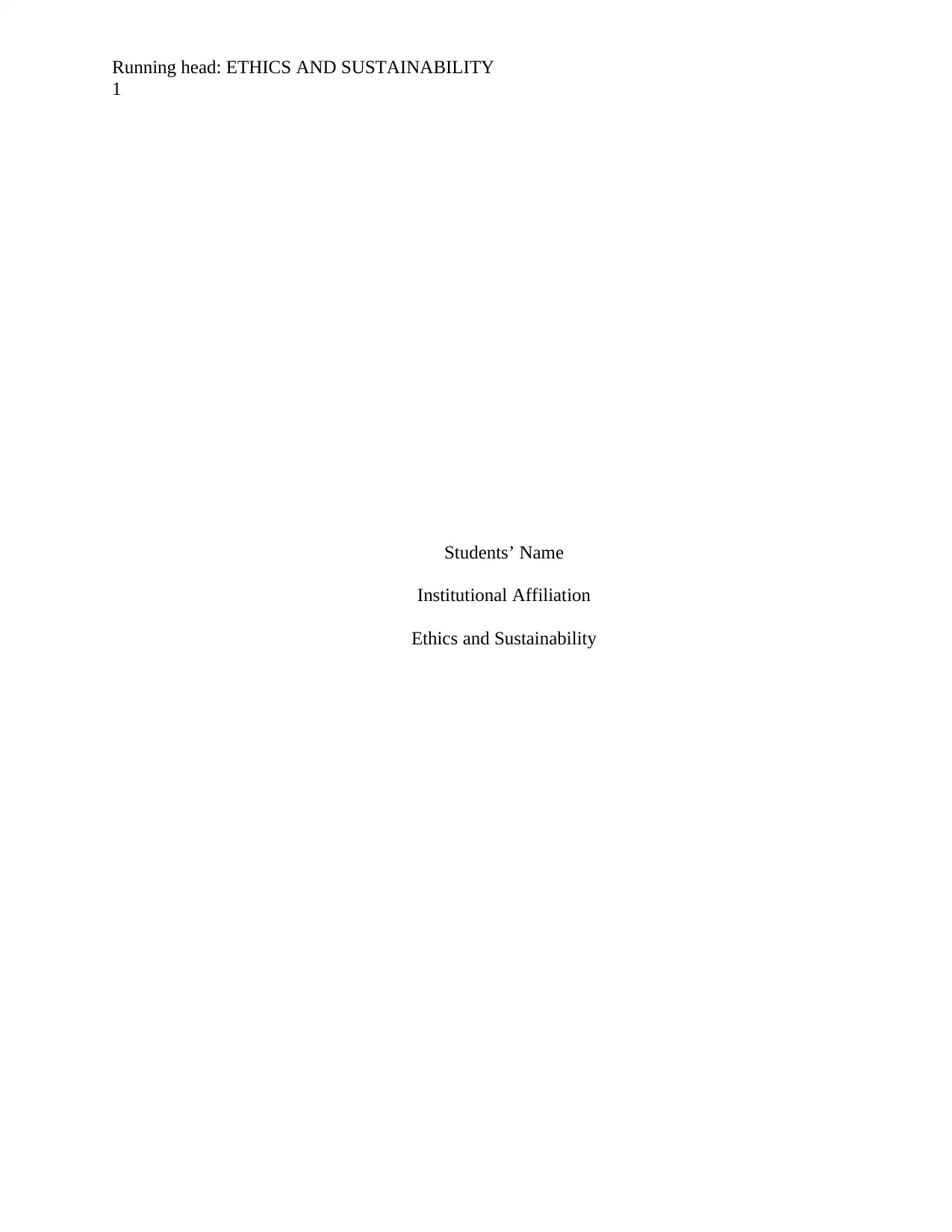
Running head: ETHICS AND SUSTAINABILITY
1
Students’ Name
Institutional Affiliation
Ethics and Sustainability
1
Students’ Name
Institutional Affiliation
Ethics and Sustainability
Secure Best Marks with AI Grader
Need help grading? Try our AI Grader for instant feedback on your assignments.
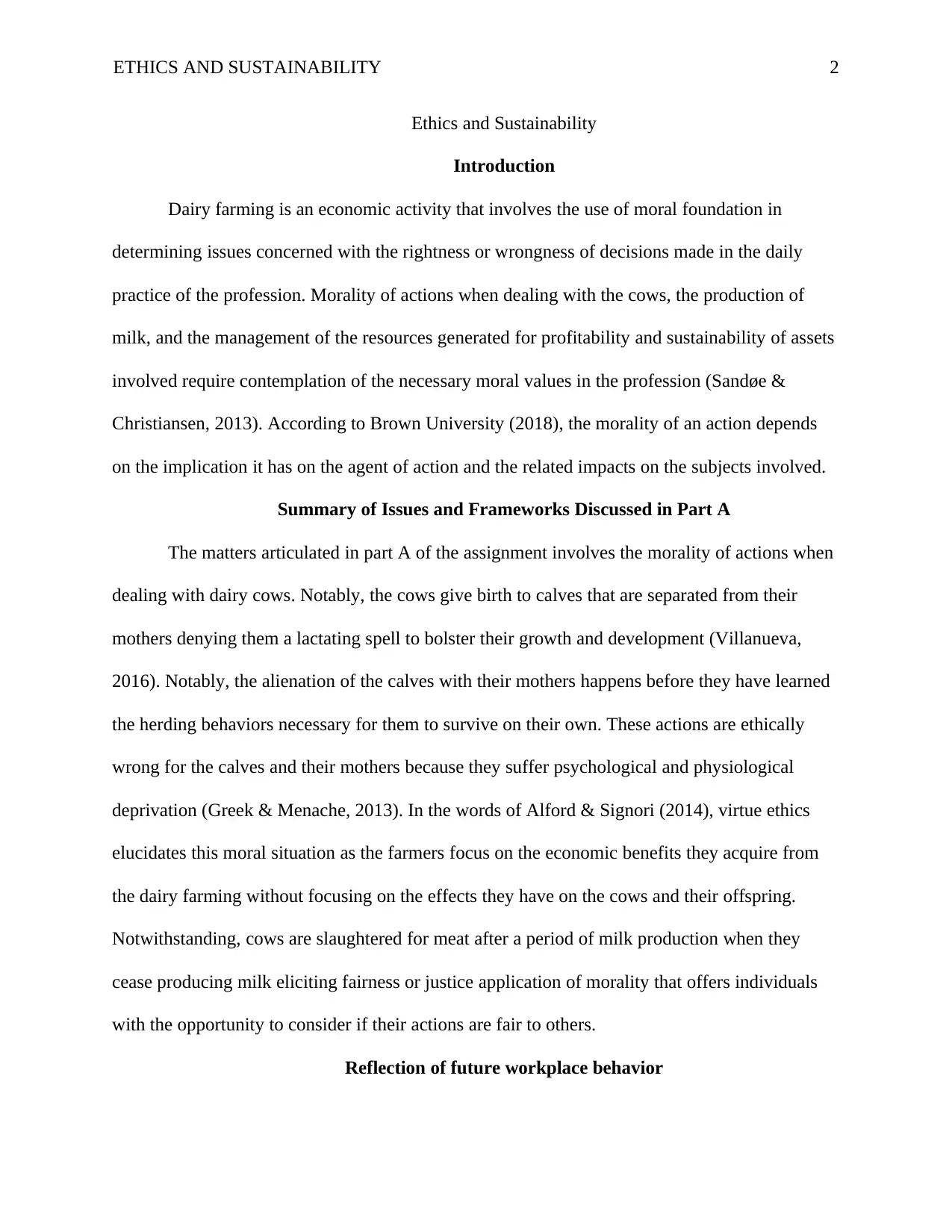
ETHICS AND SUSTAINABILITY 2
Ethics and Sustainability
Introduction
Dairy farming is an economic activity that involves the use of moral foundation in
determining issues concerned with the rightness or wrongness of decisions made in the daily
practice of the profession. Morality of actions when dealing with the cows, the production of
milk, and the management of the resources generated for profitability and sustainability of assets
involved require contemplation of the necessary moral values in the profession (Sandøe &
Christiansen, 2013). According to Brown University (2018), the morality of an action depends
on the implication it has on the agent of action and the related impacts on the subjects involved.
Summary of Issues and Frameworks Discussed in Part A
The matters articulated in part A of the assignment involves the morality of actions when
dealing with dairy cows. Notably, the cows give birth to calves that are separated from their
mothers denying them a lactating spell to bolster their growth and development (Villanueva,
2016). Notably, the alienation of the calves with their mothers happens before they have learned
the herding behaviors necessary for them to survive on their own. These actions are ethically
wrong for the calves and their mothers because they suffer psychological and physiological
deprivation (Greek & Menache, 2013). In the words of Alford & Signori (2014), virtue ethics
elucidates this moral situation as the farmers focus on the economic benefits they acquire from
the dairy farming without focusing on the effects they have on the cows and their offspring.
Notwithstanding, cows are slaughtered for meat after a period of milk production when they
cease producing milk eliciting fairness or justice application of morality that offers individuals
with the opportunity to consider if their actions are fair to others.
Reflection of future workplace behavior
Ethics and Sustainability
Introduction
Dairy farming is an economic activity that involves the use of moral foundation in
determining issues concerned with the rightness or wrongness of decisions made in the daily
practice of the profession. Morality of actions when dealing with the cows, the production of
milk, and the management of the resources generated for profitability and sustainability of assets
involved require contemplation of the necessary moral values in the profession (Sandøe &
Christiansen, 2013). According to Brown University (2018), the morality of an action depends
on the implication it has on the agent of action and the related impacts on the subjects involved.
Summary of Issues and Frameworks Discussed in Part A
The matters articulated in part A of the assignment involves the morality of actions when
dealing with dairy cows. Notably, the cows give birth to calves that are separated from their
mothers denying them a lactating spell to bolster their growth and development (Villanueva,
2016). Notably, the alienation of the calves with their mothers happens before they have learned
the herding behaviors necessary for them to survive on their own. These actions are ethically
wrong for the calves and their mothers because they suffer psychological and physiological
deprivation (Greek & Menache, 2013). In the words of Alford & Signori (2014), virtue ethics
elucidates this moral situation as the farmers focus on the economic benefits they acquire from
the dairy farming without focusing on the effects they have on the cows and their offspring.
Notwithstanding, cows are slaughtered for meat after a period of milk production when they
cease producing milk eliciting fairness or justice application of morality that offers individuals
with the opportunity to consider if their actions are fair to others.
Reflection of future workplace behavior
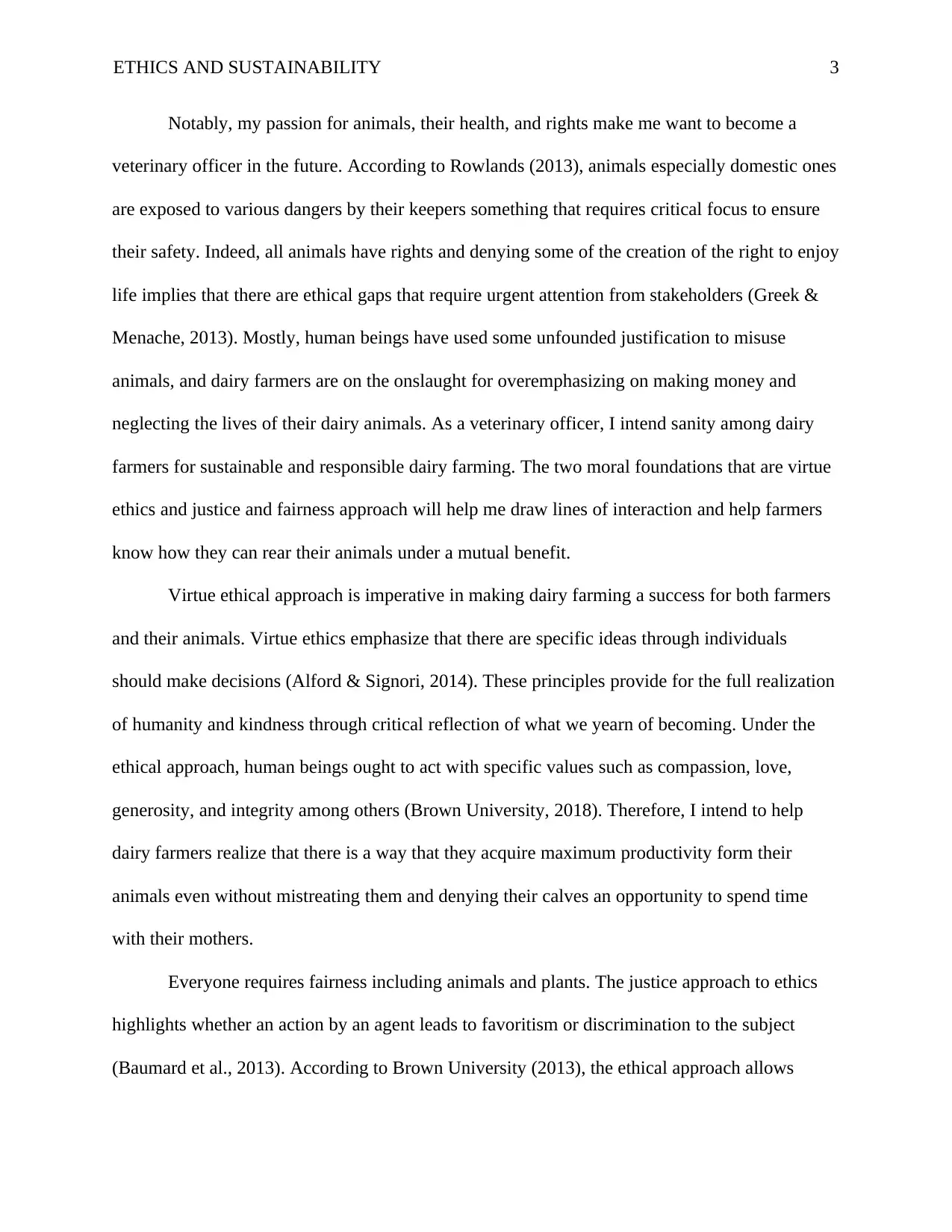
ETHICS AND SUSTAINABILITY 3
Notably, my passion for animals, their health, and rights make me want to become a
veterinary officer in the future. According to Rowlands (2013), animals especially domestic ones
are exposed to various dangers by their keepers something that requires critical focus to ensure
their safety. Indeed, all animals have rights and denying some of the creation of the right to enjoy
life implies that there are ethical gaps that require urgent attention from stakeholders (Greek &
Menache, 2013). Mostly, human beings have used some unfounded justification to misuse
animals, and dairy farmers are on the onslaught for overemphasizing on making money and
neglecting the lives of their dairy animals. As a veterinary officer, I intend sanity among dairy
farmers for sustainable and responsible dairy farming. The two moral foundations that are virtue
ethics and justice and fairness approach will help me draw lines of interaction and help farmers
know how they can rear their animals under a mutual benefit.
Virtue ethical approach is imperative in making dairy farming a success for both farmers
and their animals. Virtue ethics emphasize that there are specific ideas through individuals
should make decisions (Alford & Signori, 2014). These principles provide for the full realization
of humanity and kindness through critical reflection of what we yearn of becoming. Under the
ethical approach, human beings ought to act with specific values such as compassion, love,
generosity, and integrity among others (Brown University, 2018). Therefore, I intend to help
dairy farmers realize that there is a way that they acquire maximum productivity form their
animals even without mistreating them and denying their calves an opportunity to spend time
with their mothers.
Everyone requires fairness including animals and plants. The justice approach to ethics
highlights whether an action by an agent leads to favoritism or discrimination to the subject
(Baumard et al., 2013). According to Brown University (2013), the ethical approach allows
Notably, my passion for animals, their health, and rights make me want to become a
veterinary officer in the future. According to Rowlands (2013), animals especially domestic ones
are exposed to various dangers by their keepers something that requires critical focus to ensure
their safety. Indeed, all animals have rights and denying some of the creation of the right to enjoy
life implies that there are ethical gaps that require urgent attention from stakeholders (Greek &
Menache, 2013). Mostly, human beings have used some unfounded justification to misuse
animals, and dairy farmers are on the onslaught for overemphasizing on making money and
neglecting the lives of their dairy animals. As a veterinary officer, I intend sanity among dairy
farmers for sustainable and responsible dairy farming. The two moral foundations that are virtue
ethics and justice and fairness approach will help me draw lines of interaction and help farmers
know how they can rear their animals under a mutual benefit.
Virtue ethical approach is imperative in making dairy farming a success for both farmers
and their animals. Virtue ethics emphasize that there are specific ideas through individuals
should make decisions (Alford & Signori, 2014). These principles provide for the full realization
of humanity and kindness through critical reflection of what we yearn of becoming. Under the
ethical approach, human beings ought to act with specific values such as compassion, love,
generosity, and integrity among others (Brown University, 2018). Therefore, I intend to help
dairy farmers realize that there is a way that they acquire maximum productivity form their
animals even without mistreating them and denying their calves an opportunity to spend time
with their mothers.
Everyone requires fairness including animals and plants. The justice approach to ethics
highlights whether an action by an agent leads to favoritism or discrimination to the subject
(Baumard et al., 2013). According to Brown University (2013), the ethical approach allows
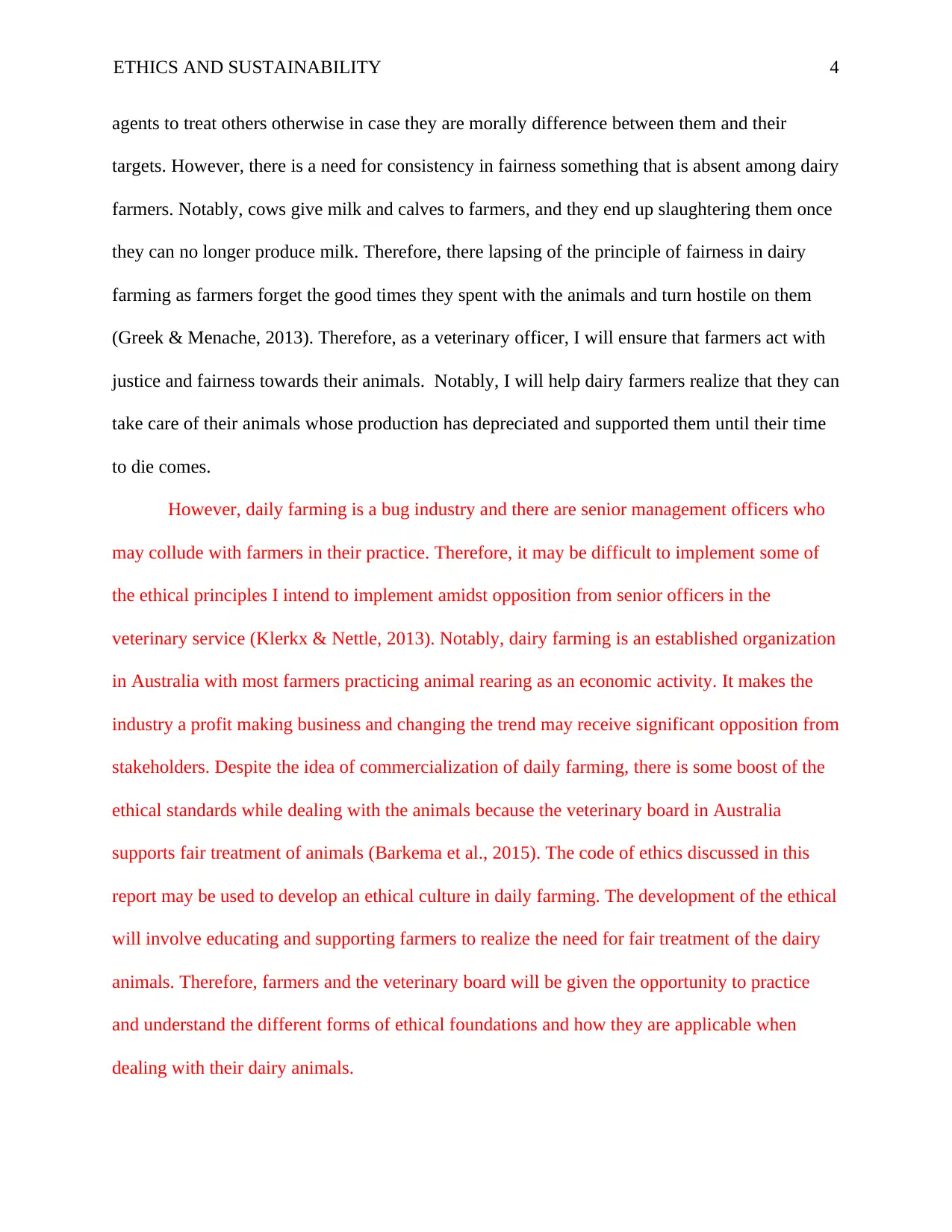
ETHICS AND SUSTAINABILITY 4
agents to treat others otherwise in case they are morally difference between them and their
targets. However, there is a need for consistency in fairness something that is absent among dairy
farmers. Notably, cows give milk and calves to farmers, and they end up slaughtering them once
they can no longer produce milk. Therefore, there lapsing of the principle of fairness in dairy
farming as farmers forget the good times they spent with the animals and turn hostile on them
(Greek & Menache, 2013). Therefore, as a veterinary officer, I will ensure that farmers act with
justice and fairness towards their animals. Notably, I will help dairy farmers realize that they can
take care of their animals whose production has depreciated and supported them until their time
to die comes.
However, daily farming is a bug industry and there are senior management officers who
may collude with farmers in their practice. Therefore, it may be difficult to implement some of
the ethical principles I intend to implement amidst opposition from senior officers in the
veterinary service (Klerkx & Nettle, 2013). Notably, dairy farming is an established organization
in Australia with most farmers practicing animal rearing as an economic activity. It makes the
industry a profit making business and changing the trend may receive significant opposition from
stakeholders. Despite the idea of commercialization of daily farming, there is some boost of the
ethical standards while dealing with the animals because the veterinary board in Australia
supports fair treatment of animals (Barkema et al., 2015). The code of ethics discussed in this
report may be used to develop an ethical culture in daily farming. The development of the ethical
will involve educating and supporting farmers to realize the need for fair treatment of the dairy
animals. Therefore, farmers and the veterinary board will be given the opportunity to practice
and understand the different forms of ethical foundations and how they are applicable when
dealing with their dairy animals.
agents to treat others otherwise in case they are morally difference between them and their
targets. However, there is a need for consistency in fairness something that is absent among dairy
farmers. Notably, cows give milk and calves to farmers, and they end up slaughtering them once
they can no longer produce milk. Therefore, there lapsing of the principle of fairness in dairy
farming as farmers forget the good times they spent with the animals and turn hostile on them
(Greek & Menache, 2013). Therefore, as a veterinary officer, I will ensure that farmers act with
justice and fairness towards their animals. Notably, I will help dairy farmers realize that they can
take care of their animals whose production has depreciated and supported them until their time
to die comes.
However, daily farming is a bug industry and there are senior management officers who
may collude with farmers in their practice. Therefore, it may be difficult to implement some of
the ethical principles I intend to implement amidst opposition from senior officers in the
veterinary service (Klerkx & Nettle, 2013). Notably, dairy farming is an established organization
in Australia with most farmers practicing animal rearing as an economic activity. It makes the
industry a profit making business and changing the trend may receive significant opposition from
stakeholders. Despite the idea of commercialization of daily farming, there is some boost of the
ethical standards while dealing with the animals because the veterinary board in Australia
supports fair treatment of animals (Barkema et al., 2015). The code of ethics discussed in this
report may be used to develop an ethical culture in daily farming. The development of the ethical
will involve educating and supporting farmers to realize the need for fair treatment of the dairy
animals. Therefore, farmers and the veterinary board will be given the opportunity to practice
and understand the different forms of ethical foundations and how they are applicable when
dealing with their dairy animals.
Secure Best Marks with AI Grader
Need help grading? Try our AI Grader for instant feedback on your assignments.
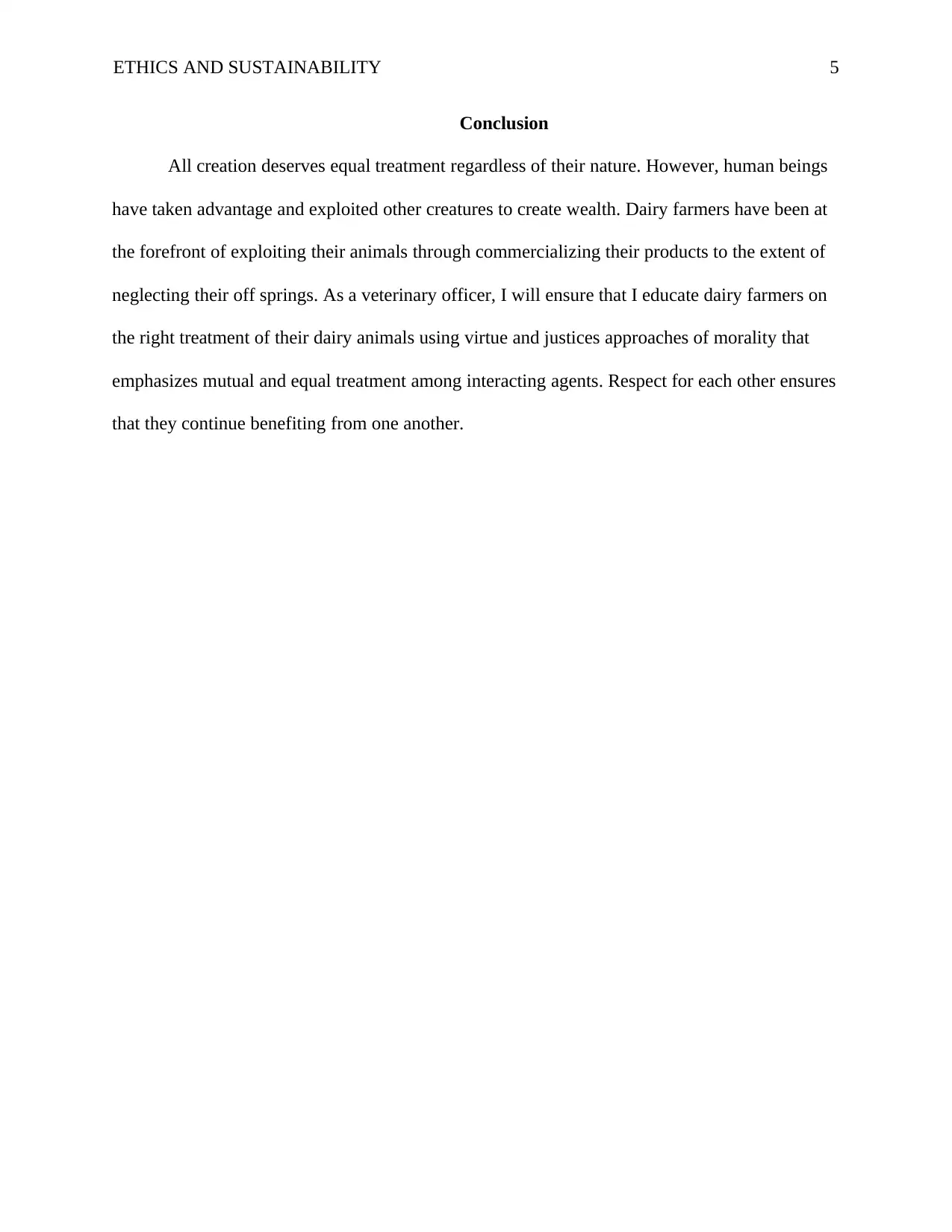
ETHICS AND SUSTAINABILITY 5
Conclusion
All creation deserves equal treatment regardless of their nature. However, human beings
have taken advantage and exploited other creatures to create wealth. Dairy farmers have been at
the forefront of exploiting their animals through commercializing their products to the extent of
neglecting their off springs. As a veterinary officer, I will ensure that I educate dairy farmers on
the right treatment of their dairy animals using virtue and justices approaches of morality that
emphasizes mutual and equal treatment among interacting agents. Respect for each other ensures
that they continue benefiting from one another.
Conclusion
All creation deserves equal treatment regardless of their nature. However, human beings
have taken advantage and exploited other creatures to create wealth. Dairy farmers have been at
the forefront of exploiting their animals through commercializing their products to the extent of
neglecting their off springs. As a veterinary officer, I will ensure that I educate dairy farmers on
the right treatment of their dairy animals using virtue and justices approaches of morality that
emphasizes mutual and equal treatment among interacting agents. Respect for each other ensures
that they continue benefiting from one another.
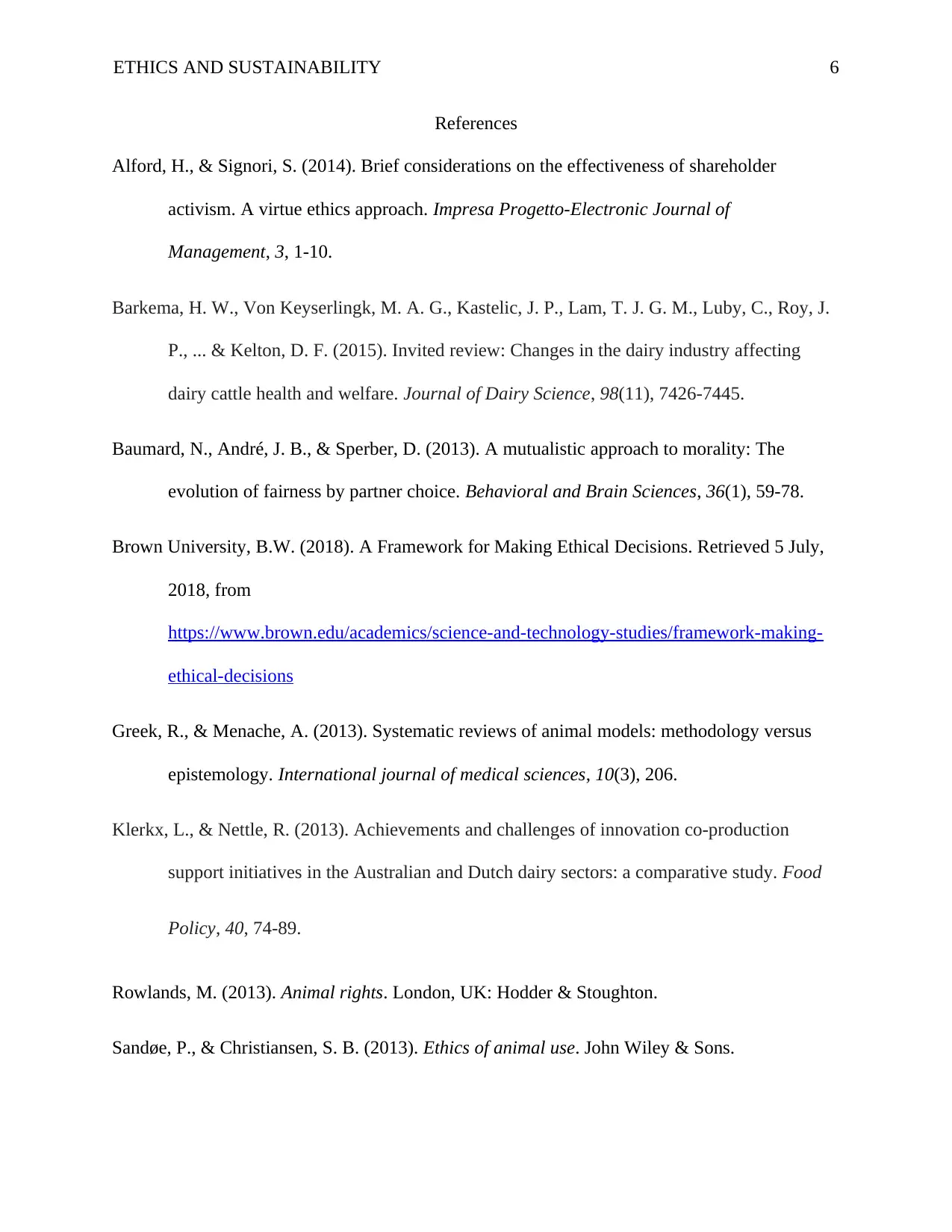
ETHICS AND SUSTAINABILITY 6
References
Alford, H., & Signori, S. (2014). Brief considerations on the effectiveness of shareholder
activism. A virtue ethics approach. Impresa Progetto-Electronic Journal of
Management, 3, 1-10.
Barkema, H. W., Von Keyserlingk, M. A. G., Kastelic, J. P., Lam, T. J. G. M., Luby, C., Roy, J.
P., ... & Kelton, D. F. (2015). Invited review: Changes in the dairy industry affecting
dairy cattle health and welfare. Journal of Dairy Science, 98(11), 7426-7445.
Baumard, N., André, J. B., & Sperber, D. (2013). A mutualistic approach to morality: The
evolution of fairness by partner choice. Behavioral and Brain Sciences, 36(1), 59-78.
Brown University, B.W. (2018). A Framework for Making Ethical Decisions. Retrieved 5 July,
2018, from
https://www.brown.edu/academics/science-and-technology-studies/framework-making-
ethical-decisions
Greek, R., & Menache, A. (2013). Systematic reviews of animal models: methodology versus
epistemology. International journal of medical sciences, 10(3), 206.
Klerkx, L., & Nettle, R. (2013). Achievements and challenges of innovation co-production
support initiatives in the Australian and Dutch dairy sectors: a comparative study. Food
Policy, 40, 74-89.
Rowlands, M. (2013). Animal rights. London, UK: Hodder & Stoughton.
Sandøe, P., & Christiansen, S. B. (2013). Ethics of animal use. John Wiley & Sons.
References
Alford, H., & Signori, S. (2014). Brief considerations on the effectiveness of shareholder
activism. A virtue ethics approach. Impresa Progetto-Electronic Journal of
Management, 3, 1-10.
Barkema, H. W., Von Keyserlingk, M. A. G., Kastelic, J. P., Lam, T. J. G. M., Luby, C., Roy, J.
P., ... & Kelton, D. F. (2015). Invited review: Changes in the dairy industry affecting
dairy cattle health and welfare. Journal of Dairy Science, 98(11), 7426-7445.
Baumard, N., André, J. B., & Sperber, D. (2013). A mutualistic approach to morality: The
evolution of fairness by partner choice. Behavioral and Brain Sciences, 36(1), 59-78.
Brown University, B.W. (2018). A Framework for Making Ethical Decisions. Retrieved 5 July,
2018, from
https://www.brown.edu/academics/science-and-technology-studies/framework-making-
ethical-decisions
Greek, R., & Menache, A. (2013). Systematic reviews of animal models: methodology versus
epistemology. International journal of medical sciences, 10(3), 206.
Klerkx, L., & Nettle, R. (2013). Achievements and challenges of innovation co-production
support initiatives in the Australian and Dutch dairy sectors: a comparative study. Food
Policy, 40, 74-89.
Rowlands, M. (2013). Animal rights. London, UK: Hodder & Stoughton.
Sandøe, P., & Christiansen, S. B. (2013). Ethics of animal use. John Wiley & Sons.
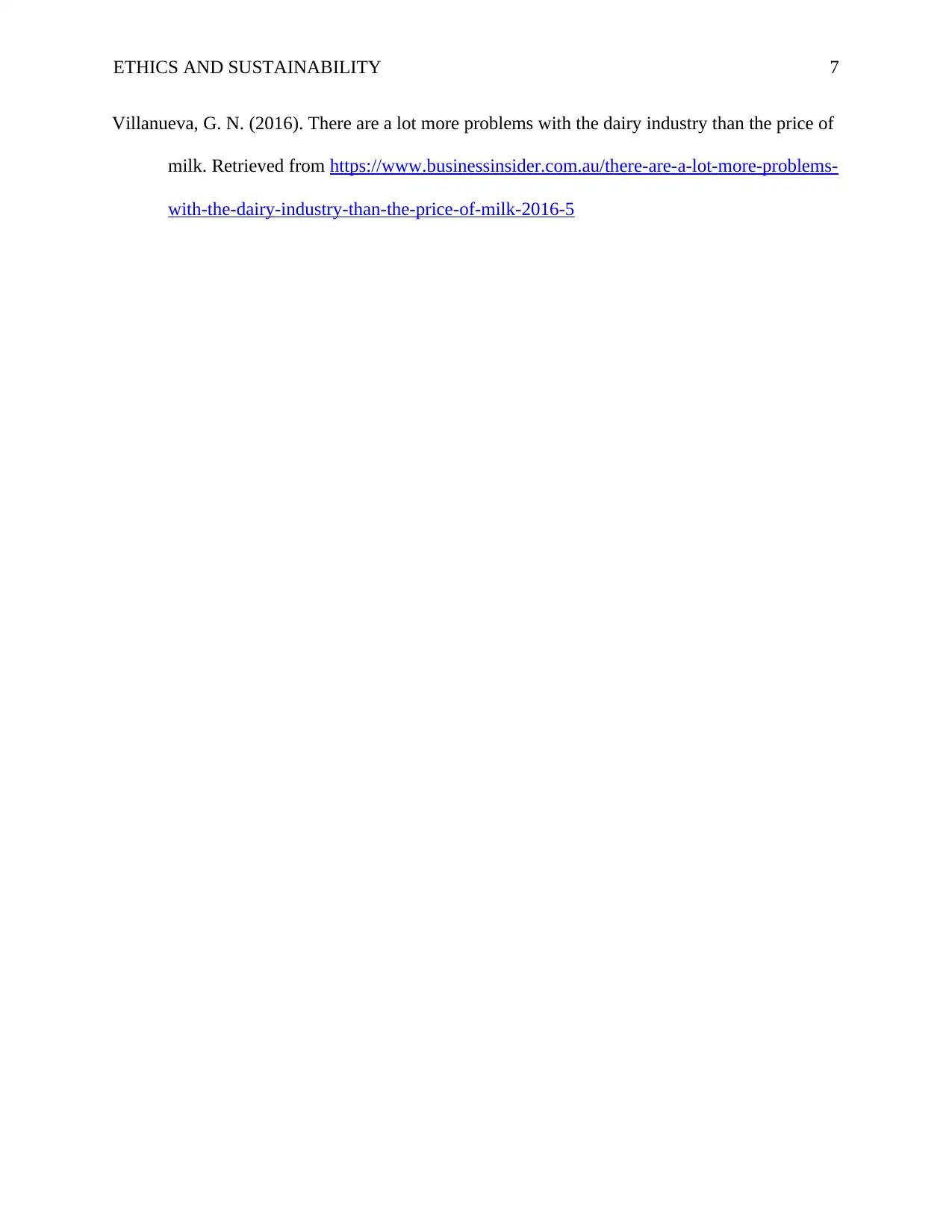
ETHICS AND SUSTAINABILITY 7
Villanueva, G. N. (2016). There are a lot more problems with the dairy industry than the price of
milk. Retrieved from https://www.businessinsider.com.au/there-are-a-lot-more-problems-
with-the-dairy-industry-than-the-price-of-milk-2016-5
Villanueva, G. N. (2016). There are a lot more problems with the dairy industry than the price of
milk. Retrieved from https://www.businessinsider.com.au/there-are-a-lot-more-problems-
with-the-dairy-industry-than-the-price-of-milk-2016-5
1 out of 7
Your All-in-One AI-Powered Toolkit for Academic Success.
+13062052269
info@desklib.com
Available 24*7 on WhatsApp / Email
![[object Object]](/_next/static/media/star-bottom.7253800d.svg)
Unlock your academic potential
© 2024 | Zucol Services PVT LTD | All rights reserved.